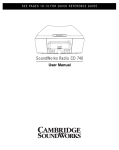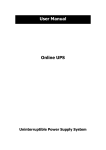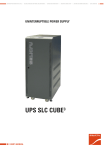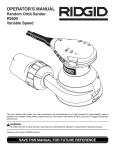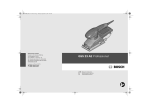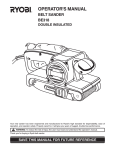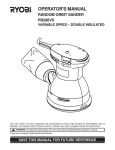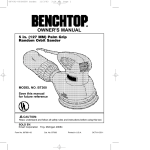Download Zanussi ZC 605 M Operating instructions
Transcript
MODE D'EMPLOI - HANDLEIDING GEBRAUCHSANLEITUNG - OPERATING INSTRUCTIONS CUISINIÈRE MIXTE GAS-EN ELEKTRISCH FORNUIS GAS-ELEKTROHERD ELECTROGAS COOKER ZC 605 M BE ENGLISH IMPORTANT THE GUARANTEE This new appliance is easy to use, however, to obtain the best results, it is important to read this booklet and to follow all the instructions before using it for the first time. The booklet contains the necessary information regarding installation, use and maintenance, as well as giving useful advice. Your new cooker is covered by guarantee. You will find the guarantee certificate enclosed. If you are missing anything, contact your retailer, giving the date of purchase, model, and the registration number which is printed on the identification plate. We ask you to bear in mind that for the guarantee to be operated, it is necessary to fill in and send the larger part of the guarantee to Electrolux Technical Assistance & Service within 8 days of purchase, so that we can provide registration. We advise you that the smaller part of the certificate, as well as your receipt and proof of purchase, should be shown when required to personnel of Electrolux Technical Assistance & Service. Without following this procedure, the repair personnel will have to charge you more for the repair. The Zanussi Technical Assistance Service, through its numerous authorized Centres, provides assistance to the most important makes of electrical domestic appliances. In case of necessity contact the nearest Centre by consulting the telephone directory under the name ZANUSSI or, of course, the yellow pages under the section Electrical Domestic Appliances/ Repairs. This appliance complies with the following E.E.C. Directives: • 73/23 - 90/683 (Low Voltage Directive); • 89/336 (Electromagnetical Compatibility Directive); • 90/396 (Gas Appliance Directive); • 93/68 (General Directives); and subsequent modifications. Appliance Class 1 and Category: Class 2 Sub-Class 1 II 2E+3+ Appliance set for use with gas type: G20/25 - 20/25 mbar Voltage tension: 230 V ~ 50 Hz Total electric power rating: 2.250 kW max MANUFACTURER: ELECTROLUX ZANUSSI ELETTRODOMESTICI S.p.A. Viale Bologna 298 47100 FORLÌ (Italy) Once your appliance has been installed by a qualified installer according to the recommendations contained in the second part of this brochure, we request you to read the following pages in order to get the best use from your cooking appliance. These instructions are only valid for countries whose identification symbols are shown on the inside cover of this information brochure and on the appliance itself. 56 WARNINGS - GAS AND ELECTROGAS COOKERS It is very important that this instruction book should be kept safely for future consultation. If the appliance should be sold or given to another person, please ensure that the booklet goes together with it, so that the new owner can know of the functions of the machine and also be aware of the warnings. This warnings has been given for the safety of you and others. We therefore ask you to carefully read the procedures of installing and using this cooker. • This appliance has been designed for use by adults. Take care, therefore, that children do not attempt to play with it. • This product is intended for the cooking of food and must not be used for other purposes. • The work of installation must be carried out by competent and qualified installers according to the regulations in force. • Any modifications to the domestic electrical mains which may be necessary for the installation of the appliance should be carried out only by competent personnel. • It is dangerous to modify, or attempt to modify, the characteristics of this appliance. • • Unstable or deformed pans should not be placed on the burners or plates in order to avoid accidents caused by upsetting or boiling over. • Particular care should be taken when cooking with oil or fat. • • • • The appliance remains hot for a long time after being switched off. Supervise children at all times, paying attention that they do not touch surfaces or remain in the vicinity of the appliance when in use or when not completely cooled. If the appliance is fitted with a cover, its function is to protect the surface from dust when closed and to accumulate splashes of grease when open.Do not use for other purposes. • • • • • • • Always clean the cover before closing. • Leave the burners and/or plates to cool before closing. • All the covers, in plate glass or enamel, are removable to facilitate cleaning. • • Always ensure that the knobs are in the « » (Stop) position when the appliance is not in use. • • Always insert the dripping pan when using the grill or when cooking meat on the grid. Pour a little water into the dripping pan to avoid grease burning and creating unpleasant smells. • • Always use oven gloves to remove dishes from the oven. • The accessories (grid and dripping pan) should be washed before using for the first time. Take care when using cleaning products in spray form: never direct the spray onto the resistance or the thermostat bulb. • • • • If, when placing food in the oven, or when removing it, a large quantity of oil, juice, etc. spills onto the bottom of the oven, re-clean before starting to cook to avoid unpleasant smoke and also the possibility of these substances catching fire. Ensure that air can circulate around the gas appliance. Poor ventilation can produce a lack of oxygen. WARNING: The use of a gas cooking appliance produces heat and humidity in the room in which it is installed. Ensure good ventilation of the room keeping natural ventilation openings clear or installing an extractor hood with a discharge tube. In case of doubt ask installer for advice. For reasons of hygiene and safety this appliance must always be kept clean. A build up of grease or other food can cause fires. Avoid installation of the cooker near inflammable material (e.g. curtains, tea towels, etc.). Supply the appliance with the type of gas stamped on the relevant adhesive label situated in the immediate vicinity of the gas connection tube. The gas oven becomes hot with the movement of air. The holes on the bottom of the oven must never be obstructed. Do not cover the sides of the oven with aluminium foil, in particular the lower part of the opening. The appliance is heavy, move it carefully. Before maintenance and cleaning disconnect the appliance and allow to cool. To facilitate ignition, light the burners before placing pans on the grid. After having lit the burners check that the flame is regular. Always lower the flame or turn it off before removing the pan. Ensure that the oven grids are inserted correctly (see instructions). If there are self-cleaning panels they should only be cleaned with soap and water (see cleaning instructions). Only heat-resistant plates may be placed in the drawer situated under the oven.Do not put combustible materials there. In case of repairs, do not attempt to correct yourself. Repairs carried out by unqualified persons can cause damage. Contact an authorized Technical Assistance Centre and insist an original spareparts. 57 CONTENTS Warning Instructions for the user Installation Use Electric Oven Programming Advice for use of oven Cooking times Maintenance Instructions for installation Gas connection Adaption to different types of gas Electrical connection What to do if... Technical Assistance and Spare Parts Pag. Pag. Pag. Pag. Pag. Pag. Pag. Pag. Pag. Pag. Pag. Pag. Pag. Pag. Pag. 57 59 59 59 60 62 63 65 66 68 69 70 71 72 72 During cooking on the grill or in the oven, the unit is kept at a high temperature in relation to the plate glass door and adjacent parts. Take care therefore, that children do not play near it. When connecting household appliances to a plug near the unit, ensure that they are kept away from the flame and the oven door. DIMENSIONS OF THE UNIT 850 OVEN DOOR PROTECTION DEVICE 600 600 All our appliances comply with the European Safety Standards. Nevertheless, in order to ensure the highest safety level, and avoid little children to be exposed to the heat when the appliance is operated, it is possible to fit a special protection device to the oven door. This device can be purchased in our Service Force Centres, specifying the relevant code ( 3 5 7 9 1 ) and the Product No. shown on the rating plate. Fitting instructions are provided with the kit package. Total power ratings and additional technical data are provided on the identification plate, attached on the lower side of the oven frame ( 58 INSTRUCTIONS FOR THE USER INSTALLATION IGNITION OF HOB BURNERS It is important that all operations are carried out by qualified personnel, in the normal manner. The specific instructions are describred in the chapter on installation. Before using the unit, take off the special protective layer which protects the stainless steel and anodyne tin parts. To ignite a burner, before positioning the saucepan, use the appropriate switch marked by a small spark, push the corresponding knob in completely and turn in an anticlockwise direction to the maximum position; upon ignition regulate the flame as required. USE If after a few attempts the burner does not ignite, check that the baffle and its cap are correctly positioned. To interrupt the supply of gas, turn the knob in a clockwise direction to the position " ". During cooking, when using fats or oils, take particular care as they can, when over-heated, selfignite. Control knobs on the cooker The knobs for using the gas cooker are found on the control panel. The regulation knobs should be turned in anticlockwise direction until the small flame symbol, and vice-versa for the larger symbol. In models provided with a safety device, the control knob must be pressed in for approximately 5 seconds until the safety valve automatically keeps the flame lit. No gas supply Maximum gas supply Minimum gas supply POTTERY Remember that a wide-bottomed pan allows a faster cooking than a narrow one. Always use pots which properly fit what you have to cook. Particularly make sure that the pans are not too small for liquids, since these could easily overflow. Moreover, the pans should not be too large for a faster cooking. In fact, grease and juices may spread on the bottom and burn easily. It is better to use non-openable moulds for baking cakes. In fact, an openable mould lets juices and sugar leak through, falling on the bottom of the oven and consequently burning on the bottom of the baking tray, making cleaning difficult. Avoid putting plastic-handled pans in the oven as they are not heat-proof. You should use oans with the right diameter to fit the burner, in order to make the most out of it, thus reducing gas consumption as in Fig. 2. It is also advisable to cover any boiling casserole and, as soon as the liquid starts boiling, lower the flame enough to keep the boiling point. Fig. 2 59 ELECTRIC OVEN (5 FUNCTIONS) Switch to choose type of cooking (Fig. 2) and thermostat regulation (Fig. 3). These two switches allow you to select the type of cooking (choice of heating element) as well as temperature, according to the requirements of the recipe. The oven light stays on in all positions. Explanation of symbols Upper and lower heating Grill Lower element Upper and lower plus circulated air Bottom heating only Turn the switch to the position “ “ and regulate the thermostat to the temperature required. Convection cooking Turn the switch to the position “ “ and regulate the thermostat to the temperature required. Defreezing Turn the switch to the position “ “. In this function, the electric ventilator fans cold air inside the oven, which begins to defreeze food. When the cooking selector switch (Fig. 2) is placed in position “ “ regulate the thermostat (Fig. 3) to position “ ● “. Defreezing Traditional cooking Turn the switch to the position “ “ and regulate the thermostat to the temperature required. Grilling “ and regulate the Turn the switch to the position “ thermostat to the temperature required. When using the grill, the oven door should be left ajar and the control panel protection inserted (Figs 4 and 5). 0 Abb. 2 FO 2124 Abb. 4 100 50 FO 0396 0 150 60 20 FO 0156 Abb. 3 FO 0375 Abb. 5 When using the oven for the first time we advise you to switch it on and allow it to heat whilst empty for approximately 45 minutes at maximum temperature. Then allow to cool down before cleaning the inside of the oven with water and a non-abrasive cleaning product. Pilot lamp When lit indicates the operation of one or more heating elements. When cooking in the oven or grill, in order to avoid over-heating, always leave the appliance’s cover open. The oven is supplied with an enamelled dripping pan for the collection of cooking juices from grilled meat or kebabs, and a grill for cooking grilled food, which can also be placed in a dish. In models equipped with an oven grill with stopper (fig. 5) and when grilling, to avoid dirtying the oven excessively, we advise you to insert the drippng pan (A-fig. 6) in the specific grids, situated under the grill (B-fig.6). If you need to cook with the dripping pan on the oven grill, place as shown in Fig. 6. FO 0190 Fig. 6 61 PROGRAMMING End of cooking numerical programmer (Fig. 7) Some models are fitted with a device which switches off the oven at the end of the cooking time programmed. The programmer has an electric clock which shows the time and a timer with an acoustic signal. Fig. 7 shows the programmer commands. All regulations are carried out by means of switches A and B. Switch A Turn in a clockwise direction to correct the time shown on the numerical display (on installaton, after electricity cut, if it is in advance or behind, etc.). Switch B Turn the switch in a clockwise direction to select: Cooking time (max. 210 minutes); Interruption of the acoustic signal (position ); Manual use of the oven (position ); Corresponding symbols appear on screen C. C FO 0158 62 A B Fig. 7 Manual operation The oven can be used normally, without any programming. For this, turn switch B in a clockwise direction until the symbol appears in the window. Programming Prepare the dish to be cooked; turn switch B in a clockwise direction to regulate the cooking time (in minutes) (window C). Turn the oven switch to regulate the cooking time. An acoustic signal indicates the end of cooking time; to cancel the acoustic signal, turn switch B to display symbol in window C. ADVICE FOR USE OF THE HOB BURNERS Initially, use a large flame for cooking, placing the regulating switch on “ “. Then regulate the flame as necessary. The external part of the flame is much hotter than the inside (core), consequently the flame points must come into contact with the bottom of the pan. Flames which exceed the pan consume gas unnecessarily. It is not necessary to use special pans for gas cookers. However, pans with thin sides transmit heat to their contents quicker than those with thick sides. And since heat is not distributed evenly around the bottom of pans food may be cooked unevenly. When using thin-based pans, contents should be stirred frequently. A thick base reduces the danger of over-heating as the bottom of the pan produces sufficient thermal compensation. We advise you to use pans of a correct size. Large, low-sided pans are more suitable than those which are narrow and high-sided as they can be heated faster. Placing small pans on the large burner does not accelerate cooking. In these conditions gas is only wasted. Use: small pans on small burners, large pans on large burners. By using a pan without a cover heat consumption is reduced. ADVICE FOR THE USE OF YOUR OVEN Traditional cooking As heat originates from top and bottom, dishes should preferably be placed in the middle. If cooking requires more heat from the bottom or the top, use the upper or lower level. Convection cooking Heat is transmitted to dishes by hot air forcibly circulated inside the oven by a fan placed at the back of the oven. By this method, heat is quickly and evenly circulated throughout the oven, permitting several different dishes to be cooked at the same time on different levels. With this cooking method, through the elimination of humidity in the air and a drier environment, smells and tastes are not given off and do not mix with those of other dishes. Thanks to this possibility of cooking on several levels, you can cook up to three different dishes at the same time, to be consumed immediately or frozen. You can also cook on only one level. In this case, it is advisable to place the dish on the lower level for better cooking control. This oven is particularly suitable for defreezing rapidly, sterilizing preserves, homemade jams and, finally, for drying mushrooms and fruit. Cooking in the multi-function oven This type of oven permits difrferent types of cooking: traditional, convection, fanned heat and grilling; cooking can therefore be optimized. 63 For the preparation of cakes Pre-heat the oven, unless indicated differently, for at least 10 minutes before use. Do not open the oven door when cooking dishes which must raise (e.g. raised pastries and soufflés); the jet of cold air would block the raising process. To check if cakes are cooked, insert a toothpick into the mixture; if it comes out clean the cake is ready. Wait until at least 3/4 of the cooking time has passed before doing this check. As a general rule remember that: A dish which is well-cooked on the outside but not sufficiently cooked inside, would have required a longer cooking time but lower temperature. On the contrary, a “dry” texture would have required a shorter cooking time but higher temperature. For the preparation of meat: Meat to the cooked in the oven should weigh at least 1 kilo to avoid its becoming too dry. If you want roasts with a good colour, use very little oil. If the piece is lean, use a little oil and butter. Butter or oil are unnecessary if the piece has a strip of fat on top. If the piece has a strip of fat on one side only, put it in the oven with this side upwards; when melting the fat will grease the lower side sufficiently. Red meat should be removed from the fridge one hour before cooking otherwise the sudden change of temperature could cause it to become tough. A roast, especially if of red meat, must not be salted at the beginning of cooking as salt causes juices and blood to seep out of the meat, thus preventing the formation of a well-browned crust. Meat should be salted after just over half the cooking time. Place the roast in the oven in a dish having a low rim; a deep dish acts as a shield and prevents heat from circulating. Meat can be placed on an ovenproof dish or directly on the grill, under which the dripping pan should be inserted to collect juice. Ingredients for gravy should only be put in the dish immediately if cooking time is brief, otherwise they should be added during the last half hour. Begin cooking rare meat at a high temperature, reducing the temperature to finish cooking the inside. The cooking temperature for white meat can be moderate throughout. The degree of cooking can be checked by pressing the meat with a fork; if it does not give the meat is cooked. At the end of cooking it is advisable to wait at least 15 minutes before cutting the meat in order that the juices are not lost. Before serving plates can be kept warm in the oven regulated at minimum temperature. For the preparation of fish Cook small fish from start to finish at a high temperature. Cook medium-sized fish initially at a high tempe- 64 rature and then gradually lower the temperature. Cook large fish at a moderate temperature from start to finish. Check that baked fish is cooked by gently lifting one side of the gut; the meat must be white and opaque throughout, except in the case of salmon, trout or similar. In any case, carefully follow the instructions of the recipe you are using. Grilling The following types of meat are suitable for grilling. Meat or offal cut in slices or pieces of various sizes but not usually very thick, poultry cut in half and flattened, fish, some vegetables (e.g. courgettes, aubergines, tomatoes, etc.), skewers of meat or fish and seafood. Meat and fish to be grilled should be lightly brushed with oil and always placed on the grill; this must be positioned on the level nearest or farthest from the grill in order to control cooking to avoid burning the surface or leaving the inside uncooked. Pour 1 or 2 glasses of water into the dripping pan in order to avoid the formation of smoke caused by drops of juice and fat. The grill can also be used to brown, toast bread and grill certain types of fruit, such as bananas, halved grapefruit, slices of pineapple, apples, etc. Fruit should not be placed too near the source of heat. Cooking times Cooking times can vary according to the type of food, its consistency and its volume. It is advisable to watch when cooking for the first time and check results in order to prepare the same dishes in the same conditions and thus obtain constantly similar results. The “table of cooking times” relating to cooking in the oven and by grill is provided as a guide. Experience will show possible variations to the values set out in the table. FO 0061 Fig. 8 QUANTITY g. TABLE FOR TRADITIONAL AND CONVECTION COOKING 1000 500 500 250 1000 1200 1000 1500 1200 1000 4000 1500 3000 1200 1000 800 Cooking times Fanned heat Level Tempe- Traditional cooking Level Tempe- FOODS 4 3 2 1 CAKES Mixture with beaten egg whites With raised mixture Shortpastry - pie base Cheesecake Apply pie Strudel Jam tarts Small cakes Biscuits Meringues BREAD AND PIZZA White bread Wholemeal bread Bread rolls Pizza FLANS Macaroni Vegetable Small quiches Lasagne MEAT Roast beef Roast pork Roast veal Roast sirloin Lamb Chicken Turkey Duck Goose Rabbit FISH Whole Fillets rature °C 4 3 2 1 rature REMARKS °C in Minutes 2 1 2 1 1 2 2 2 2 2 180 180 180 175 180 175 180 180 180 100 2 (1 and 3) 2 (1 and 3) 2 (1 and 3) 2 2 (1 and 3) 2 (1 and 3) 2 (1 and 3) 2 (1 and 3) 2 (1 and 3) 2 (1 and 3) 160 160 160 150 160 150 160 160 160 100 45 ~ 60 20 ~ 35 20 ~ 30 60 ~ 80 40 ~ 60 60 ~ 80 45 ~ 60 15 ~ 25 10 ~ 20 90 ~ 120 1 1 2 1 200 200 200 220 2 2 2 (1 and 3) 2 (1 and 3) 175 175 175 200 45 ~ 60 30 ~ 45 20 ~ 35 20 ~ 35 2 2 2 2 200 200 200 200 2 (1 and 3) 2 (1 and 3) 2 (1 and 3) 2 175 175 175 175 40 ~ 50 45 ~ 60 35 ~ 45 45 ~ 60 2 2 2 2 2 2 2 2 2 2 200 200 200 220 200 200 200 175 175 200 2 2 2 2 2 2 2 2 2 2 175 175 175 200 175 175 175 160 160 175 50 ~ 70 100 ~ 130 90 ~ 120 50 ~ 70 110 ~ 130 60 ~ 80 210 ~ 240 120 ~ 150 150 ~ 200 60 ~ 80 Cooked on the grill Cooked on the grill Cooked on the grill Cooked on the grill Leg Whole Whole Whole Whole In pieces 2 2 200 200 2 (1 and 3) 2 (1 and 3) 175 175 140 ~ 60 30 ~ 40 2 fish 4 fillets 1 load in tin 8 bread rolls on tray REMARKS 1) Cooking times do not include preheating, we advise you, particularly for cakes, pizzas, bread, to preheat the oven for approximately 10 minutes. 2) The indication of levels between brackets is the one to be used when cooking on several levels. 3) All cooking must be carried out with the oven door closed. GRILLING Quantity FOODS Steak Pork chops Sausages Chicken pieces Various kebabs Chicken breast Halved tomatoes Fish, fillets Scallops Welsh rarebit Slices of bread Number of pieces Grams 4 4 8 6 4 4 8 4 6 4 4 800 600 500 800 700 400 500 400 — — — Cooking time in minutes Grilling Level 4 3 2 1 4 4 4 3 4 4 4 4 4 4 4 Temperature °C max. max. max. max. max. max. max. max. max. max. max. Top Bottom 10 12 10 30 12 13 12 8 12 8 2~3 8 8 6 20 10 10 — 6 — — 1 The dripping pan must be inserted on the lowest level 65 MAINTENANCE Before each operation, disconnect the unit. Cleaning the cooker Drops of sauce, fruit juice etc., should be removed as soon as possible with a soft cloth soaked in warm detergent water. Do not use steel wool or knives to take off layers of crust. Remove stubborn marks with a well wetted soap impregnated pad, but care must be taken not to scratch the enamel. Wash the enamelled grids with water and detergent; these can also be washed a dishwasher. Take off the burner covers and the grids and wash them carefully with warm water and detergent. Dry them well before putting them back in position. Moreover, make sure that these are properly re-placed. The burner can be rubbed with steel wool or a slightly abrasive cloth. Clean the oven door and crystal cover, in models equipped with these items, only with warm water, and avoid the use of rough cloths or abrasive substances; in cookers with an automatic ignition the sparkling bulb should be cleaned periodically and accurately to avoid difficulties in lighting; furthermore check that the burner holes are not obstructed. Oven lamp replacement (Fig. 9) Disconnect the appliance. Unscrew the lamp and substitute it with another fitting for a higher temperature (300°C) with the folowing characteristics: Tension: 230 V (50Hz) Power: 15W Convection: E14 FO 0424 Fig. 9 Cleaning the oven Clean carefully the oven cavity after use when it is still warm. In fact, at this moment it is easy to take off deposits of fat or other substances such as fruit juice, sugar particles or fat. You can use warm detergent water or one of the appropriate spray oven cleaners. Do not direct the spray at the mat steel parts as this could damage them and always follow the manufacturer's instructions. Clean the oven accessories (grate, grid-plate etc.) with warm water and detergent. Remove possible incrustations with a slightly abrasive powder. Cleaning the oven door For a more complete cleaning of the oven door, it is advisable to disassemble it in the following way (Fig. 10): open the door fully, turn the two caps situated on the arm of the hinge to 180°, partially close the door to an angle of 30°, lift the door and extract from the front. Re-mount the door by reversing the operation described above. Never line any part of the oven with aluminium foil. It would result in an accumulation of heat which might damage the cooking results and also damage the enamel. Controls - Sundries Periodically check the condition of the flexible pipe of gas connection and make it replaced by skilled technicians as soon as it shows abnormalities. Annual replacement is recommended. Have the cocks periodically lubricated by skilled technicians. In case of unusual working have the range checked by skilled technicians. In ranges with cylinder holder, do not use this space to leave a non-connected or an empty cylinder. FO 0967 66 Fig. 10 Lid cleaning All the cooker lids can be disassembled, to allow a better cleaning. Enamelled lids can be dissasembled as shown in fig. 11. As regards crystal lids, follow instructions included in the chapter named "Balancing the lid". After a proper cleaning, carefully reposition the lid into its hinges. Fig. 11 FO 0418 CARE OF CATALYTIC SIDE PANELS The catalytic side panels can neutralise most food and splashes of grease when the temperature exceeds 220˚C. To facilitate cleaning, it is advisable to heat the oven, empty, above this temperature for 1 to 2 hours a week. Practical advice: . Manual cleaning of catalytic side panels is not advisable. . These side panels are irremediably damaged by the use of sprays, steel wool soaked in soap or other detergents. . With time some discolouring of the side panels may occur. This will not affect the catalytic action. . Once the side panels are saturated the cleaning process ceases. This does not effect the appliance’s operation. . Follow the advice given below in order to reduce to a minimum the formation of splashes in the oven. It is unnecessary to add water when roasting or grilling meat. The addition of water and the meat juices will contribute, during the cooking process, to the formation of fat splashes and condensation. The side panels are better protected against splashes if the dish containing the roast is covered. In this case the covering must be removed 20-30 minutes before the end of cooking; meat will be roasted better on the outside. Some large pieces of meat and turkey can certainly be cooked in this way; the inside will thus be cooked before the outside burns. Always use the dripping pan when roasting or grilling meat. The long life of your catalytic side panels is dependent on your following this fundamental advice. How to diminish splashes? Some advice: Always cook at the recommended temperature. When roasting, temperatures which are too high can contribute to the formation of splashes. Try to cook at lower temperatures (do not, of course, forget to adapt cooking times). You will save energy and roasted meat will be much more tender. Use only a small quantity of fat or oil, or even no fat at all when roasting meat. The addition of fat when grilling or roasting contributes to the formation of splashes of fat. 67 INSTRUCTIONS FOR THE INSTALLER The following instructions are meant for a qualified installer, in order that the operations of installation, regulation, and service are executed according to the existing regulations. Whenever changes are mode involving the disconnection of the machine it is necessary to proceed with maximum caution. THE MANUFACTURING COMPANY DECLINES ANY RESPONSABILITY FOR POSSIBLE DAMAGES RESULTING FROM AN INSTALLATION WHICH DOESN'T COMPLY WITH THE RULES IN FORCE INSTALLATION ENVIRONMENT Warning - This unit can be installed and can work only in constantly ventilated rooms, according to rules in force. In order to make the gas unit work properly, it is necessary that air sufficient to gas combustion can naturally flow in the room. (The installer must follow the rules in force). The air flow into the room must come directly through openings of external walls. These openings (or opening) should be realized in such a way not to be occluded both from inside and outside. Installation and maintenance must be carried out by a qualified technician, in compliance with rules in force, particularly NBND 51003. The electric coonection must be carried out in compliance with rule NBN. Our responsability will not be involved in case of accidents caused by a defective or non existent earth connection. COMBUSTION PRODUCTS DISCHARGE Gas cooking units must discharge combustion products through hoods directly connected to flues or outside (Fig. 24). POSITIONING This appliance belongs to the class "X". It has been designed to be placed close to furniture units not exceeding the height of the working level (EN 60 335-2-6) LEVELLING The appliance is provided with adjustable small feet placed in the back and front corners od the base. By adjusting the small feet (fig. 12) it is possible to change the height of the appliance so as to ensure a better levelling with other surfaces and a uniform distribution of the liquids contained in pans or pots. 68 Fig. 12 FO 0063 GAS CONNECTION Gas connection must be carried out according to the rules in force. The manufacturing company release the unit, once tested, adjusted for the kind of gas stated on the rating plate located on the back of the range, next to connection pipe. Be sure that you are going to connect the unit to the same kind of gas written on the plate. CONNECTION USING A RIGID PIPE OR A FLEXIBLE METAL PIPE To ensure higher safety, it is recommended to carry out the connection to the gas system using rigid pipes (ex. copper) or using flexible stainless steel pipes, to avoid any stress to the unit. Gas feeding pipe fitting is Gc 1/2. For this type of installation, connection to the gas supply should be carried out using only and exclusively flexible metallic tubes in conformity with rules in force. CONNECTION USING FLEXIBLE, NON METAL PIPES When the connection can be easily inspected in its full extent, there is the chance to use a flexible pipe according to the rules in force. The flexible pipe must be tightly fixed using clamps according to the rules in force. The flexible pipe should be made ready for use in such a way that: - nowhere it can reach overtemperature, other than room temperature, higher than 30°C; if the flexible pipe, to reach the cock, must run behind the range, it must be installed as shown in Fig. 13; - it is no longer than 1500 mm; - it shows no throttles; - it is not subject to traction or torsion; - it doesn't get in touch with cutting edges or corners; - it can be easily inspected in order to check its condition. YES FLEXIBLE RUBBER GAS PIPELINE ELECTRIC WIRE NO The control of preservation of the flexible pipe consists in checking that: - it doesn't show cracks, cuts, marks of burnings both on the end parts and on its full extent; - the material is not hardened, but shows its normal elasticity; - the fastening clamps are not rusted; - expiry term is not due. FLEXIBLE RUBBER GAS PIPELINE ELECTRIC WIRE If one or more abnormalities are seen, do not repair the pipe, but replace it. IMPORTANT Once installation is complete, check the perfect seal of every pipe fitting, using a soapy solution, never a flame. FO 0163 Fig. 13 69 ADAPTATION TO DIFFERENT KINDS OF GAS To adapt the appliance to a different kind of gas from the one the appliance has been set for, follow the instructions below in their order. GAS CONNECTION (Fig. 15) LPG : use the rubber pipe holder «C». Natural gas : use the pipe fitting «A». Always insert the gasket «B» (Fig. 15). Then proceed with the gas connection, as indicated in the relevant paragraphs. Fig. 14 FO 2127 HOB BURNERS NOZZLES REPLACEMENT - Remove the pan supports. - Extract the caps and the wall baffles of the burners. - Using a socket spanner 7 unscrew and remove (fig. 16) the nozzles replacing them with the ones required for the kind of gas in use (see table). Reassemble the parts following the same procedure backwards. These burners do not need any primary air regulation. HOB BURNERS ADJUSTMENT OF MINIMUM LEVEL Fig. 15 FO 0392 To adjust the minimum level: 1) turn the knob to the position of minimum flame; 2) remove the knob (Fig. 17); 3a) in case of conversion from natural gas to LPG, tightly screw the by-pass screw of the cocks; 3b) when converting from LPG to natural gas unscrew about one-fourth turn by-pass screw, until a regular small flame is reached. Reassemble the parts following the same procedure backards. Check that, turning quickly the knob from the maximum position to the minimum one, the flame does not go out. Normal power Fig. 16 Reduced power NATURAL GAS Mark BURNER 70 m3/h 1/100 kW LPG Mark G20 G25 20 25 mbar mbar kW g/h 1/100 G 30 G 31 Auxiliary 1 0,33 70 0,095 0,111 50 72,5 71,5 Semi-rapid 2 0,45 96 0,190 0,221 71 145 143 Rapid Natural gas: 3 LPG : 2,8 0,65 119 0,286 0,332 86 203 200 ELECTRICAL CONNECTION The unit is preset to work with a voltage of single phase 230 V. Before making the connection make sure that: — the energy power available in the user's house is sufficient for the normal supply of this appliance (see rating plate). — the unit is correctly connected to earth through a suitable plug and according to the installation country Laws. — the socket or the omnipolar switch used for the connection must be easilv reached with the installed appliance. The appliance is supplied without electric cord: consequently, you have to install a plug fit for the load shown in the serial number plate. The plug has to be connected to an adequate socket. If you wish to directly connect to the mains, you have to interpose an omnipolar switch with a minimum opening between contacts of 3 mm, between the unit and the mains, complying with the existing regulations. The brown live wire (originating from the clamp of the cooker junction box) must always be connected to the phase of the mains supply. In any case, the supply cord must be positioned in such a way as it doesn't reach in any point a temperature higher by 50°C than the room temperature. Should the supply cord need to be replaced, use only type H05RR-F cables. It is necessary that the yellow/ green earth wire is about 2cm longer than the live and neutral ones (Fig. 17). After the connection, test the heating elements for about 3 minutes to ensure that they are working correctly. Phase Neutral wire Ground (yellow - green) FO 0480 Fig. 17 The manufacturer refuses any responsability in cases where normal safety measures are not observed. 71 WHAT TO DO IF THE APPLIANCE DOESN'T WORK If the appliance doesn't work properly check the following points before asking for service: The flow of gas seems abnormal Make sure that: — the flame speader holes are not obstructed; — the pressure regulator is working; — the bottle valve is completely open. Gas smell in the room Make sure that: — the gas valve is not open; — the gas supply tube is well positioned and in good condition; remember to replace it at least once a year. Never look for an escape of gas with a match; use instead soapy water. The oven doesn't heat — Make sure that the oven knobs are in the correct worrking positions. Cooking time is too long — Check that the temperature is correct for the type of food to be cooked. The cooker produces smoke — We advise you to clean the oven after use. Splashes of fat can occur during the cooking of meat and, if the oven isn't cleaned properly, these produce smoke and bad smell. (see paragraph concerning cleaning). The oven lamp doesn't work — The lamp has burnt out. To replace it follow the instructions given in the relative paragraph. If, after following all the above checks the appliance still doesn't work, call your nearest Service Centre givin them all the necessary information, such as model and serial number of the appliance. MAINTENANCE - TECHNICAL ASSISTANCE The gas cocks must be periodically lubricated to ensure good working and safety. Maintenance should be performed as follows: • Remove the knob and panel after having taken out fastening screws. • Loosen the two screws located at the sides of the cock bar. • Remove the cone and clean it carefully. • Then, apply a thin layer of grease non soluble in water, suitable for gas cocks. Take care not to obstruct the gas flow holes by an excess of grease. Reassemble the whole with utmost care performing the operations described above inversely. ORIGINAL SPARE PARTS This machine, before leaving the factory, has been tested and studied by many experts and specialists, in order to give you the best results. Any repair work which needs to be carried out should be done with the utmost care and attention. For this reason we reccomend that for any problem you contact the dealer who sold it to you, or our nearest authorized Service Centre, specifying the nature of the problem and the particular model which you own. Original spare parts, certified by the manufacturer of the product and marked with the following sign, can only be found at our approved Technical Assistance Centres and in authorised Spare Parts Shops. 72



















